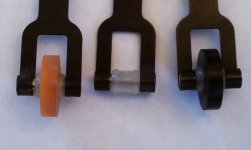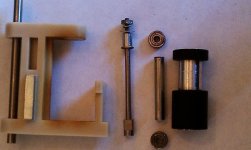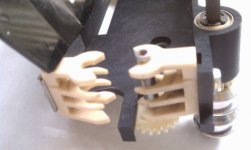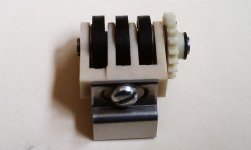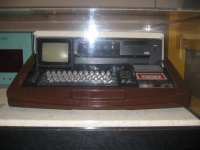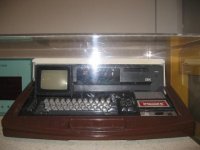It's been a while since I updated this thread and for what it's worth I thought I would give a brief overview of what I've been up to for the last few months.
One of my goals from the beginning has been to archive the original IBM tape cartridges I have, and any others I might come across. The original cartridges I had all suffered from brittle or broken drive belts, and in many cases the belts had become fused to the tape itself where the two elements had been in contact. In these cases the belt could literally rip the magnetic coating from the tape. I found that a small amount of distilled water applied between the two surfaces with a small brush helped to separate them without damage. After any excess moisture dried out I was able to replace the broken belts with belts removed from NOS cartridges. Most of the cartridges found on eBay are at least 20 years younger than the originals, but completely useable. There are some tricks to installing the new belts and tensioning the tape- but it's not rocket science.
Having rebuilt all of my original cartridges it was time to try them out. I was surprised and very happy to find that every tape I had rebuilt was readable and seemed to work well in the tape drives. I was able to read the contents of each tape, but I decided not to run the tapes any more than necessary until I can copy them. I was hoping to find a tape cartridge among the ones I have called the "Customer Support Cartridge". This cartridge contains the commands used to perform tape to tape copying and is something I will have to find before I can archive my tapes.
While checking the tapes I noticed a few things about the operation of the tape drives that were a little troubling. Neither drive seemed to lock the tape in position against the capstan. This meant that I had to actually push the tape against the capstan with my hand. The internal drive was fairly quiet, but the 5106 auxilary drive would emit a loud squealing every other minute or so. Rather than take any chances I decided to pull the drives out and look them over. The tape positioning problem turned out to be caused by broken guide rollers underneath the tape itself. There are 4 hard rubber, spring mounted rollers that the tape rides on as it is inserted into the drive. On the bottom of each tape are two recesses cut into the heavy aluminum plate that forms the core of the cartridge. Normally, when the cartridge reaches the proper position two of the rollers push up into the recesses and hold the tape in position against the capstan. On both of my drives the rubber rollers had become brittle and broken away from the plastic hubs they were mounted to. Luckily, I found that a size 00 rubber faucet washer is identical in size to the rubber originally used for the rollers. The washers fit the plastic hubs perfectly as well, so the tape positioning problem seems to be solved.
The squealing noise from the 5106 drive was almost surely caused by dried up grease in the spindle bearings. There are 6 small R series bearings in each drive. 4 R4-ZZ bearings for the forward and reverse drive spindles, and 2 R2-ZZ bearings for the capstan spindle. On the squealing drive forward and reverse spindles rotated roughly, and a closer look showed that the grease in two of them was completely dried up. I decided to replace all of the bearings with new ones since I want to be able to rely on the drives, and after sitting idle for 30 years the condition of the bearings was questionable. I will save the old bearings, but for now, the new bearings give me a little peace of mind.
Getting the internal drive out of the 5100 required me to open up the "gate" that the backplane and cards are attached to. I had held off doing this before because typically the foam cushioning under the cards is in very deteriorated condition- ie "a mess". This turned out to be the case. The foam deteriorates into a black, tarry, sticky mess that gets on everything. It took me two hours of careful work with q-tips to carefully wipe the goop from the top of the cards and everywhere else it had attached itself. I found that the foam was attache to the computer housing with some type of peel and stick adhesive which was easily peeled away. The foam consists of two 1/8" layers of what I believe was polyurethane foam (similar to conductive foam), with a thin plastic sheet between them. The sheet looks like it may have some antistatic coating on it. If anyone knows anything about this foam "sandwich" material or who made it I would like to find out more about it. As a replacement for the original foam I bought a 1 X 1 ft. X1/4" piece of HD conductive foam which should substitute for the original very well.
I am in the process of finishing up this work and should have the computer and drives together and working again soon. I completed some work on the 5103 printer, which is probably worth mentioning. I had two problems with the printer. One of the hard plastic brackets that mount the tractor feed had broken, and no replacements are available. I was able to repair the broken plastic with a product called Plastex. All I can say is the product worked as advertised and repaired the broken plastic so the part is 100%. Another problem I had was that a plastic gear and it's metal shaft were missing from the ribbon drive. I ended up using a plastic resin casting kit from the hobby shop. I made a mold out of silicone rubber and used a two part urethane casting resin to duplicate the original gear. I actually made several just in case, and I must say that the results far exceeded my expectations! For the shaft, I used a stock piece of steel rod and used a Dremel tool and a file to put a flat and a small groove for a snap-ring on one end. The original rollers had also disappeared, and I found that faucet washers of the exact size made perfect replacements. That's two uses for faucet washers on my 5100!
I'm attaching a few pics that illustrate some of what I have gotten into here. I may be able to claim the prize for most boring post, but hopefully something here will prove helpful to someone. I'd love to hear from anyone else who has experience working on these machines.
slimbob
